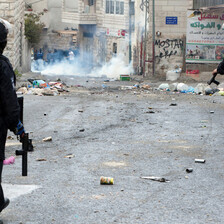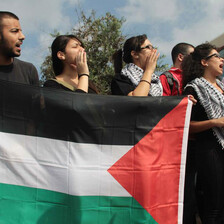The Electronic Intifada the Galilee 1 May 2012

Palestinians carry signs reading the names of villages destroyed during the 1948 Nakba in the village of Abu Snan during the annual March of Return, 26 April.
AFP PhotoThousands of Palestinian citizens of Israel gathered in the western Galilee for the annual March of Return last week, on 26 April.
Timed to coincide with the annual Israeli “Independence Day” celebrations, each year for the past 15 years participants have marched to the lands of different villages destroyed during the Nakba — the 1947-48 catastrophe during which Zionist militias evicted approximately 750,000 Palestinians from what then became Israel. Hundreds of Palestinian villages were blown up with dynamite and demolished.
This year, the march ended on land belonging to Kweikat, a village that was ethnically cleansed by Israeli forces in July 1948. Out of sight was the nearby Israeli settlement of Beit HaEmek, built on the ruins of Kweikat. The march passed within eyeshot of other nearby Israeli settlements built on the ruins of Amqa, whose people were also driven out in July 1948. The two villages are near to Akka (Acre), and were situated in the Akka region of Palestine according to the boundary demarcations of the British Mandate (which ruled Palestine before 1948).
Siwar Aslih, a psychologist who works in Haifa, makes a point of coming to the event every year. “It’s a very unique march,” she said. “Every year they try to go to a new village, to add new things.” I asked what her personal reason was for making the effort each year. “For the living memory of every Palestinian who died in the Nakba,” she replied.
War planes overhead
On the journey north from Jerusalem, I saw many Israelis picnicking and enjoying barbecues in parks, beaches and public squares. Israeli flags were draped all over cars, homes and public spaces. It was their “Independence Day.” As we stopped for breakfast on a Haifa beach, warplanes flew overhead in an ostentatious display of military prowess.
Although the Zionist movement declared Israel as a state on top of Palestine on 14 May 1948, the day is celebrated in Israel according to the Jewish religious calendar, and so falls on different days of the Gregorian calendar each year. The March of Return is purposely timed to fall on the same day as “Independence Day,” to make a very definite point.
“We have a point here that the independence of this country is the same as the Nakba for our people,” said Aslih. “I think this memory should be relived every year.”
The march proceeded from a small nearby town called Abu Snan. Palestinians from all over the parts of historic Palestine now called Israel, as well as Jerusalem, had arrived in cars and coaches to participate. Palestinians from the West Bank, Gaza and in exile were not permitted to enter.
A handful of anti-Zionist Jews joined in, and activists from Zochrot (“Remembering” in Hebrew, the organization set up to educate Israelis about the Nakba) were in attendance.
Particularly striking was the wide range of ages of those present. Enthusiastic teenagers and youth led energetic chants against Israel, calling for the full return of Palestinian refugees, naming all the towns and villages of pre-1948 Palestine that the refugees would return to, and singing freedom songs. Mothers and fathers brought their young children along to make a day of it, perhaps wanting to avoid the festival of Israeli flags flooding the country that day.
“The old people from the village are also here,” Aslih said. “They are speaking about the traumatic experience of the Nakba, which is I think a brilliant idea. I’ve seen grandfathers with their grandsons, [and] many kids — this also makes it special.”
At the rally, there were speeches, songs, food, drink and stalls. Vendors sold books and maps of Palestine, and there was a scale model portraying what Kweikat looked like before its destruction. There was also a moment of silence for the martyrs and singing of the Palestinian anthem “Mawtani” (“My country”).
Knowing what you’re fighting for
Ma’ath Musleh is a Palestinian student from Jerusalem. He regularly travels across the West Bank to support and take part in different demonstrations against the occupation when he can. The March of Return is special to him too: “It’s always important to go to these ethnically cleansed towns. When you’re here you just know what you’re fighting for.”
“In Ramallah they celebrate: the PA [Palestinian Authority] have brainwashed everyone and there is no commemoration of the Nakba, there are celebrations just to say we did something in the middle of al-Manara [square]. When you see a crowd this big you just get optimistic, you get the hope,” he explained.
Musleh is critical of the PA and its now seemingly-dormant plan to declare a state in part of the West Bank.
“Our struggle is not to get them to recognize a state, or three settlements that are illegal … it’s not complicated. There are Palestinian refugees who should return back home, or get the right to return back home. After that, everyone lives in this land and has equal rights. When you hear all these Palestinians chanting for the right of return, you know that they know what the fight is about.”
He was not the only one skeptical of the PA. Palestinian youth that day included many chants condemning the policies of the PA, pressuring them not to sell out the refugees in negotiations with Israel. “Oh Abbas, oh Qureia: the Right of Return is not for sale” was one such popular chant, addressing PA President Mahmoud Abbas and negotiator Ahmed Qureia.
Budour Hassan is a Palestinian activist from Nazareth and a law student at the Hebrew university in Jerusalem. “My favorite thing about protests in Palestine ‘48,” she mused on Twitter after the demonstration, referring to the area of historic Palestine now called Israel, “is that we can chant against the PA, Mahmoud Abbas and Hamas without being silenced.”
A big difference with demonstrations in the West Bank and Gaza was the lack of violent suppression by the Israeli military or police. There was no tear gas, no rubber-coated steel bullets and certainly no live rounds. There were no police in sight, although I heard rumors they were on standby at a gas station on the main road several hundred meters away.
Despite an array of laws that discriminate against them as non-Jews, Palestinians in Israel are nominal citizens. The military regime against them ended in 1966, and they do have the right to vote in the Israeli parliament, the Knesset. Despite that, Israel has not hesitated to use violence against its “own” Palestinians.
On 30 March 1976, the first Land Day was violently suppressed by Israeli forces, and six Palestinians were killed after protests and a general strike against land confiscations in the Galilee. In October 2000, 13 Palestinians in Israel were killed by Israeli forces after they came out in support of the unarmed popular uprising that marked the start of the second intifada.
Thankfully, last Thursday was not like that. “Israel is not interested in a violent confrontation with us at this time,” Hassan told me after the march. “If they did, people in ‘48 [Palestinians in present-day Israel] would rise up against them.”
Racist legislation
In yet another example of the racist Israeli legislation passed in recent years, in March 2011 the Knesset passed an amendment known as the “Nakba law.” It made it possible to fine any public body that benefits from government funding (e.g. schools, universities, local authorities) if it holds events that commemorate “Independence Day or the day of the establishment of the state as a day of mourning.”
“The ambiguous wording of this law raises concerns that fines will be imposed for holding events in which the Nakba is mentioned in any way,” a statement from Adalah, the Legal Center for Arab Minority Rights in Israel, said. In May 2011 Adalah filed a petition against the law, but the Israeli high court ruled in January of this year that the law could stand (“Israeli high court ignored the chilling effect already caused by the ‘Nakbah law’,” Adalah, 5 January 2012).
Abir Kopty, also from Nazareth, frequently takes part in demonstrations all over occupied Palestine. She has taken part in the March of Return every year for the last ten years. “It’s important as a Palestinian, especially during the Independence Day of Israel, while Israelis are celebrating, to tell them that your celebration is actually on the ruins of my people,” she said.
As we spoke, the day’s events were winding down, and people were heading back to Abu Snan. Some Israelis, rather slow on the uptake, had finally caught onto what was taking place nearby, and decided to stage a small counter-demonstration on the main road several hundred meters away. We spoke over the sound of a loud sound system they had brought.
“I think they want to prove .. that this is theirs,” said Kopty. “It’s not: it’s a stolen land, a stolen country. We are here actually to assert our right to return to our villages and homes. Without this there won’t be justice for Palestinians.”
Strong spirit
I observed that throughout the day, there was a very strong spirit of positive Palestinian cultural nationalism. Kopty agreed: “We want to assert that we as Palestinians inside Israel are part of the Palestinian people and we are part of the struggle and the cause. I’m very proud actually, because today you don’t see any party flags in the demonstration, [only Palestinian flags] — there is total unity.
“What unites us as Palestinian people as a whole everywhere, in exile, in home, in diaspora, in ‘67 [the West Bank and Gaza Strip], in ‘48, is actually the right of return. What unites us as Palestinians is actually the Nakba. Look how many youth came to this march. Because I come every year, [I can see that] it’s growing and growing.
“It’s passing from one generation to another, without giving up our rights,” Kopty added. “This is a message to the Israeli apartheid that no matter what they do, no matter how much efforts they put for 64 years to destroy our identity, to demolish our narrative and our history, it’s not going to work.”
Asa Winstanley is a journalist based in London who is currently reporting from Palestine.





